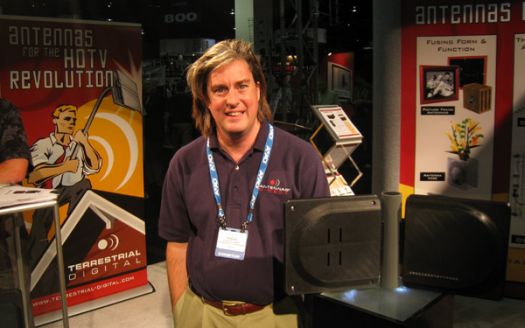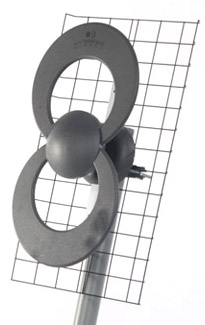At a press conference in Denver this week, Antennas Direct CEO Richard Schneider showed a prototype "Smart Antenna" - one that tunes itself for best reception based on feedback from a compatible digital tuner or television. It is Schneider's hope that antennas like this, which combine maximum performance with minimum set-up hassles, will help ease the transition into the age of digital television, while exposing more people to the great digital and high definition content that is available for free over the airwaves.
The goal of designing a so-called Smart Antenna is to bring off-the-air reception back into the mainstream and to create a compact indoor antenna that offers the reliability and consistency of an outdoor antenna for those who cannot (or choose not to) mount an antenna outside. The specification for a smart antenna comes from the Consumer Electronics Association - spec CEA 909A to be precise. There are both "single wire" and "dual wire" versions of the specification, differing in how the control codes are sent back and forth from antenna to tuner either over the standard coax antenna cable or via a separate 6 conductor wire.

When a smart antenna is plugged into a compatible television or digital set-top box and the "auto-scan" function is run on that connected tuner, the antenna automatically activates and deactivates certain elements, adjusts polarity and beam orientation, and it does so automatically and electronically for the maximum reception performance on each individual channel. In effect the antenna becomes a narrow band antenna optimized for each specific channel that is being tuned in. Because the antenna has a two way connection to the tuner, the antenna knows which channel is being watched and adjusts itself accordingly for the best reception.

In terms of "regular" antennas, Antennas Direct is also offering seven new models which are compatible with the high VHF and UHF frequencies which will be used for 98% of the digital channels on the air now or to be launched on or before February 18th of next year when all analog over-the-air broadcasts will go dark.
Schneider believes that the 13% to 15% of the population who currently use antennas exclusively to watch TV will actually grow to 25% or more for the following reasons:
As consumers tighten their belts in the ever-worsening economy, Schneider believes luxury items like paid TV will be the first to go. Assuming a $70/month cable or satellite TV bill, Schneider points out that the money spent on pay TV could instead be used for:
Or, if the money is instead invested into a retirement savings plan, an individual could end up with $100,000 or more additional money in their retirement fund (if invested over one's lifetime), simply by choosing free TV over paid TV.
Of course, Schneider's not-so-hidden agenda is that if consumers switch back to free TV, they'll need to buy an antenna, and hopefully it will be one of his. And in support of this agenda, Antennas Direct is hitting the road with a rolling "Antennas Now" RV which is furthering DTV education and giving away hundreds of antennas across the country in preparation for the analog cutover of 2009.
Is now the time to "cut the cable?" Richard Schneider thinks so, and he hopes you'll agree.
More information: